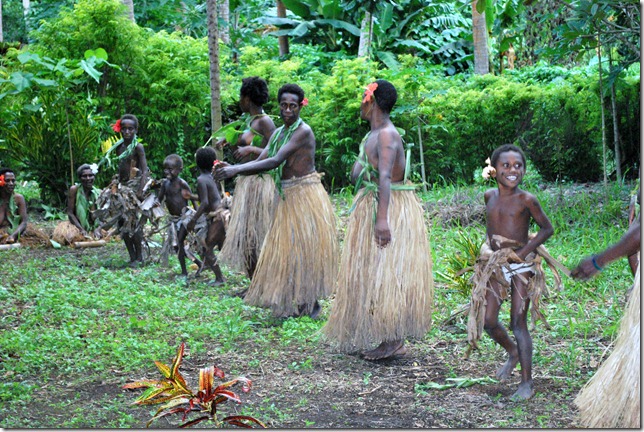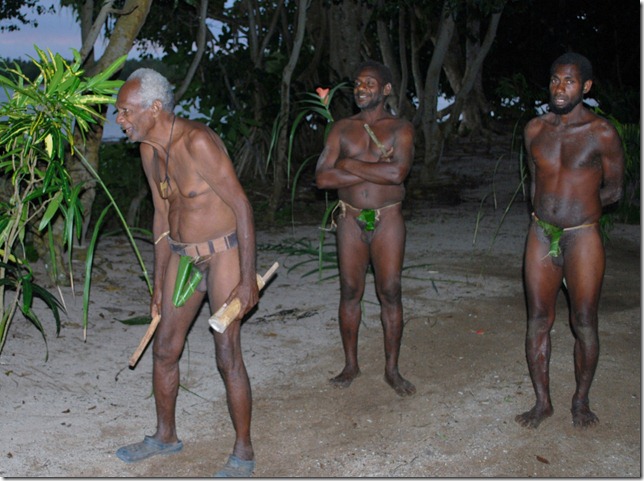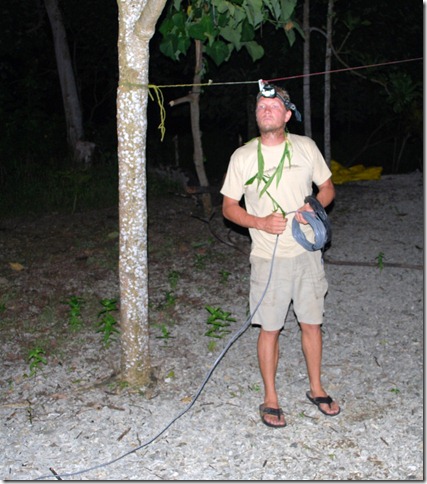Jake told us to be at the yacht club at 3pm, but when he didn’t show up, we followed the trail to the village. He was waiting for us at the end of the trail and said we should come into the village to look over some things for sale by the women. Only one woman showed up with a few shells, necklaces, and a pamplemousse. We lounged around one of the afternoon houses, basically a floor with a roof and no walls that lets you enjoy the breeze and shade in the warmth of the day. Jake explained that we were on island time and the dance would occur eventually, but not in the immediate future. We took the time to relax, play with the village kids, and chat. Just at the preparations were nearing completion, a French boat anchored in the bay and I jogged back to the dinghy to invite them to the dance. Even though they’d just set the anchor and we’d never met, they jumped into the dinghy and joined us ashore.
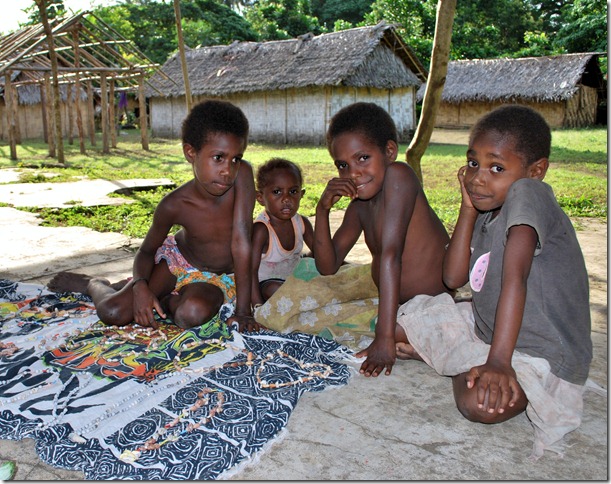 Hanging out with the village kids before the dance performance
Hanging out with the village kids before the dance performance
Preparations were complete and Jake was trying to gather us all up when we arrived back in the village. Things got underway with an official welcome to Banam Bay. Six girls and women, in order of increasing age, stood in a line to welcome us. They were bare-breasted with grass skirts, flowers in their hair, and a necklace made of leaves. We lined up as well and shook hands with each one, saying hello. The last one placed a necklace of leaves over our heads and we entered the women’s dance area, which was a sort of clearing with trees surrounding most of it. We walked through two lines of women dressed in the same way as the welcoming party and facing each other. When we reached the other side, Jake explained that the men and women would dance separately. The women would dance two dances – the first celebrating childbirth and the second celebrating marriage and becoming a woman. There were no taboos in this area and we were free to take pictures and the women among us were welcome to join in the second dance.
Four women were seated across from us, at the other end of the two lines, and after Jake’s introduction they began to sing and beat the hollow wooden percussion instrument that’s common throughout the Pacific. The youngest dancers were girls who were 10 or so and the oldest were starting to gray. The dancing was mostly stomping the heels in time with the percussion, although the second song involved the two lines repeatedly swapping places by walking past each other in the area between the lines. Lauren joined in on the second dance, and although she’s often the most enthusiastic person on the dance floor, a woman at the far end of the lines took the prize for turning the very understated dance into a much more lively affair involving swinging arms, legs, and other appendages. At the end of the second dance, we walked each line of dancers, shaking hands with each of them and thanking them for their performance.
It was then on to the men’s dancing. The men’s dancing was put on in a taboo area near the beach that women are not allowed to enter, with an exception being made for the female tourists. There were a couple of small huts, a sort of sculpture in the shape of a large, decorative head-like percussion instrument and two rows of green shoots that had been pushed into the sand to frame the dancing area, with us at one end and the sculpture at the other end. Near the sculpture stood the chief and several middle-aged men wearing only the namba and holding the wooden percussion instrument in their left hand and a stick to strike it with in their right hand. In case it’s not clear in the pictures, the namba is basically a large leaf that’s wrapped around the penis several times and then folded under a piece of bark that’s tied around the waist like a belt. The chief looked anything but frail and 98 with his wooden drum and namba. It was clear he was excited to be leading the dancing. Jake explained that there would be three dances – a warrior dance, a pig-killing dance, and a dance that celebrates circumcision and manhood. About 15 young men and boys then filed out of one of the huts, each wearing a namba and a black feather in his hair. The first two dances were done in moving lines with the heels keeping time with the percussion and music that was lead by the chief and the other men in the rear. As in other places, the men’s dancing was much more animated with yelling and throwing their hands over their heads. The third dance was done in a circle with the chief and older men in the center and the younger men around them celebrating with yells and legs kicking back behind them. Jake seemed not to notice than he was singing along and kicking his feet as well. It was a pretty rousing performance that was met with a healthy round of applause after each dance. After the dancing, the chief thanked us for coming and asked us each to introduce ourselves with our name, our home country, what we did for work, and anything else we wanted to add. After each person finished, the chief would beat the wooden drum and say thank-you.
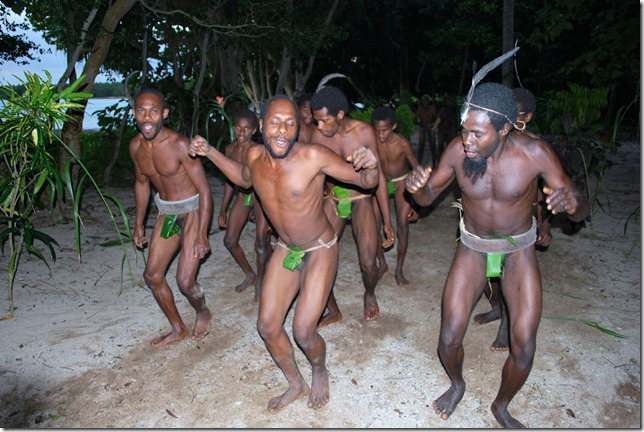 Not at all bashful in their nambas
Not at all bashful in their nambas
Next it was on to the food. They had cooked us a meal in the traditional way. Earlier in the day a fire had been lit to heat up stones, then the stones were placed in the ground with the food wrapped in banana leaves to make an underground oven. In the center was a dish of chicken and greens in coconut milk and around it was pieces of cooked tapioca. We sat in a circle around it, eating with our hands and then washing them in a bowl of seawater when we were finished. We then presented a few small gifts we’d brought for the village and paid for the dancing and food. Martin had brought a bag of medical supplies, a jerry jug, a hurricane lamp, and some kerosene and we’d brought some school supplies.
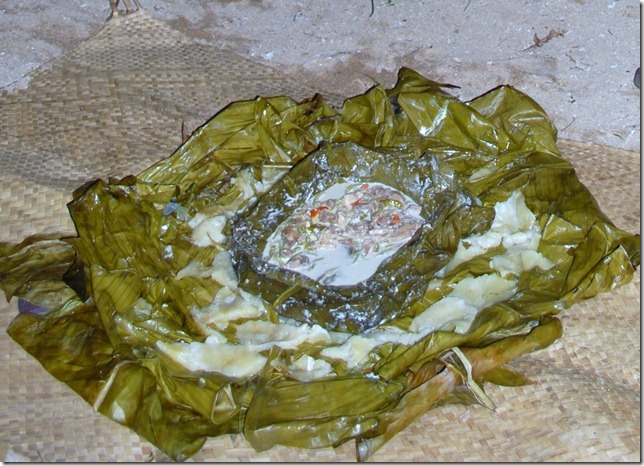 Leftover “lap-lap” that the dancers soon devoured
Leftover “lap-lap” that the dancers soon devoured
Night was falling as we made our way to Jake’s house. Several houses along the way were light with a single flashlight, a kerosene lamp, or a small fire. The village was quiet, but not yet sleeping. Back at Jake’s place I was able to run the wire from the battery hut to the living hut and install the two LED lights which he hung outdoors so we could see to have a round of kava. He made a short heartfelt speech that I’ll remember for a long time. He said that kava was a special way to greet guests and he was glad to share with all of us (the ladies got to partake as well). He said that he’d had a solar panel for 3 years but never had light in his home and that he would always remember us for bringing a second life to his home. He downed the first cup of what was definitely the strongest kava we’ve tasted and we chatted for 15 minutes or so before making our way through the dark village and woods back to the dinghies resting on the beach.
We said goodbye to the French couple, who we’d just met and to Martin. Martin has been our best friend and a great companion for nearly a year now and from here our paths diverge. He’ll stay longer in Vanuatu and then make his way through Asia and the Red Sea back to Europe next spring. We’re planning to take the South Africa route across the Indian Ocean and, if all goes according to plan, will be nearing the US about the time he’s in Greece. We’ll probably miss each other in Darwin and Bali by a week or two. The next time we meet it will likely be as tourists on land in Europe or the US instead of as sailors at sea or in a small island anchorage.


